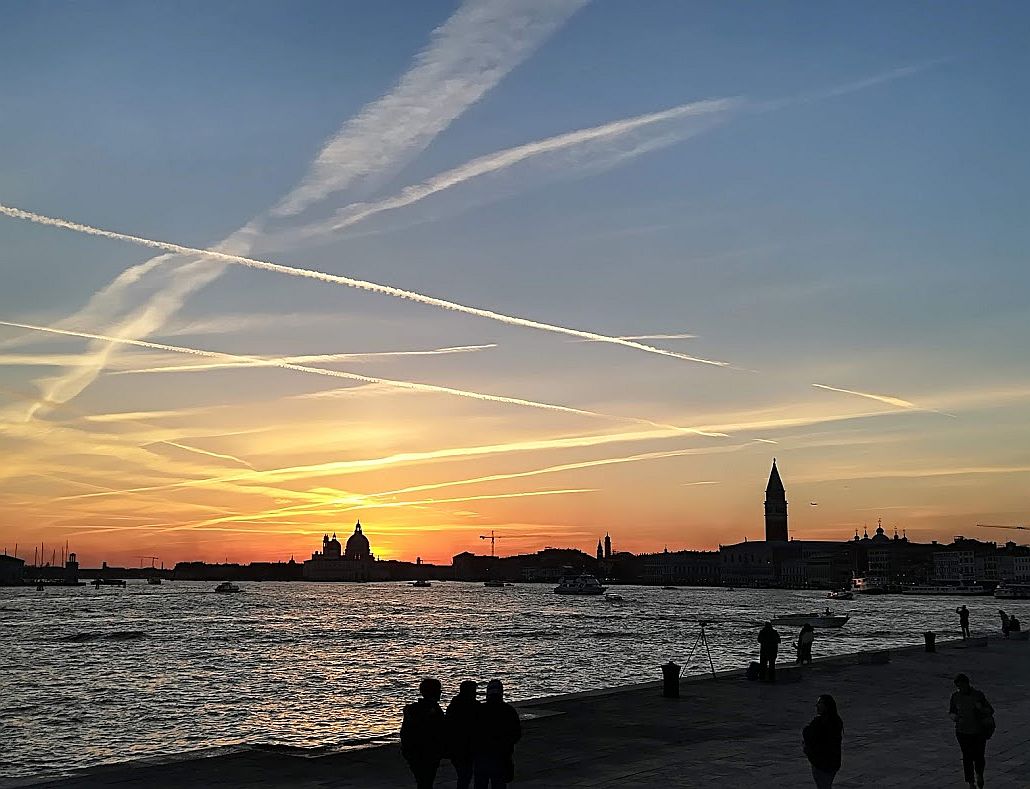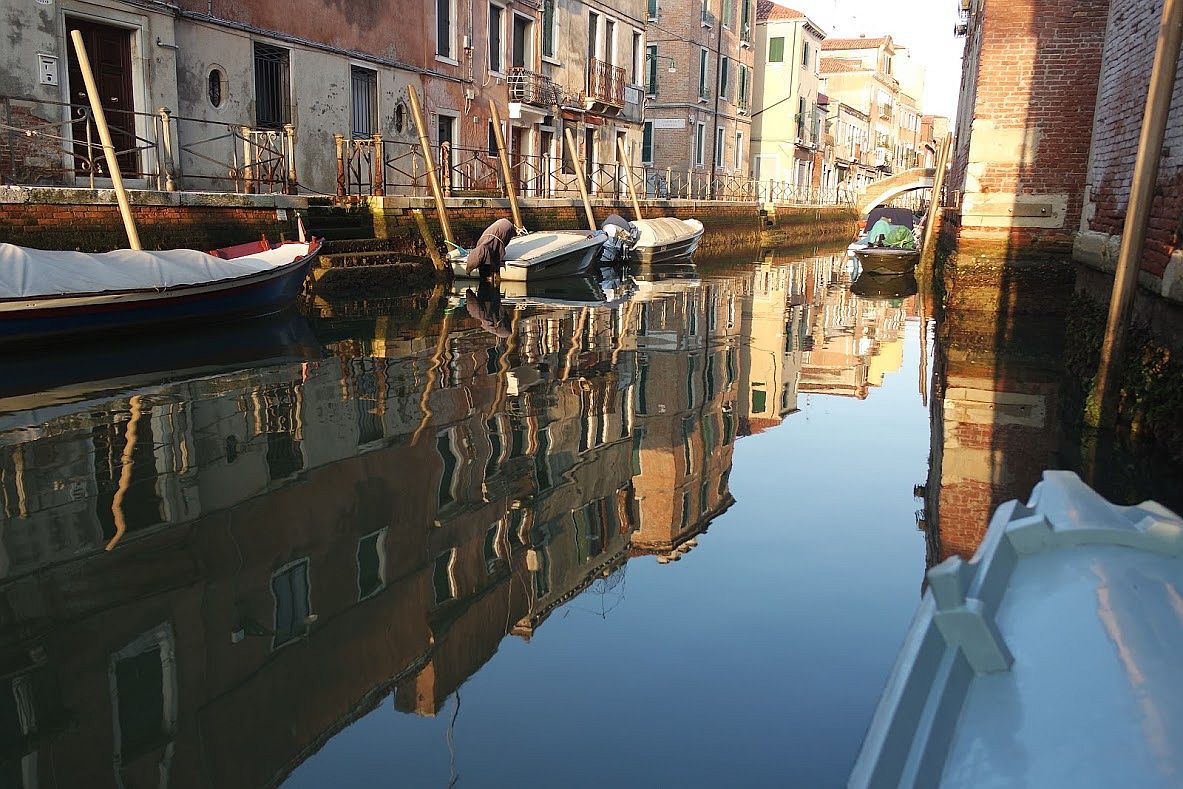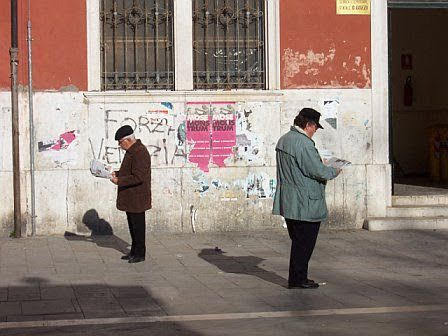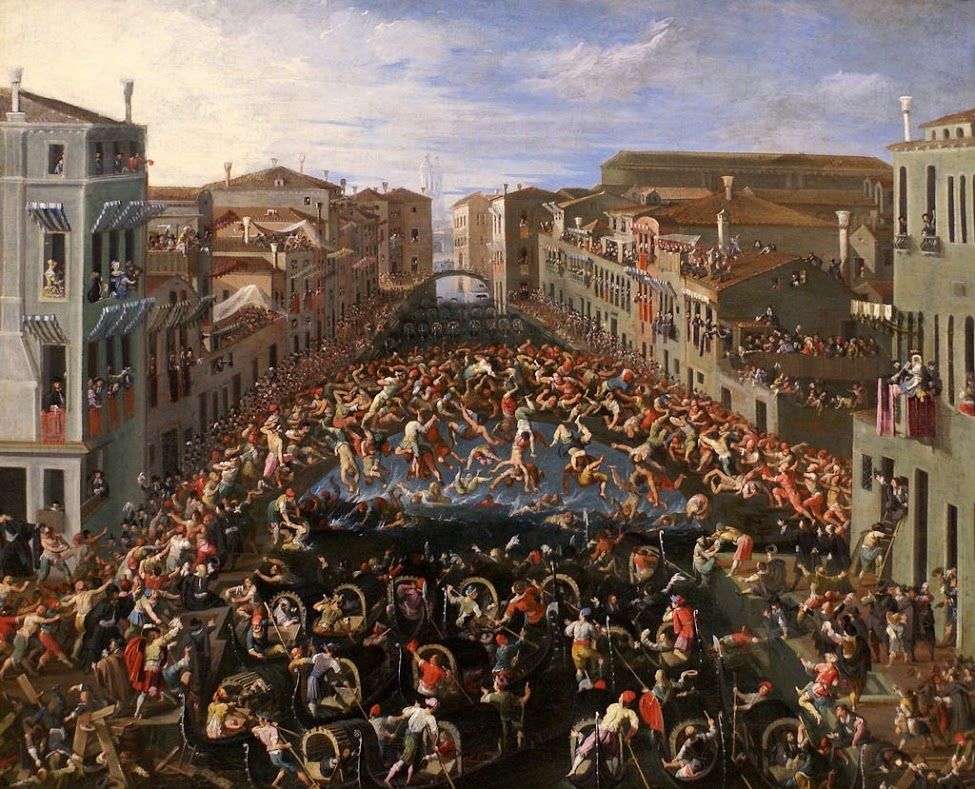
Back in the depths of the summer heat, about the time when the sun began to set and the air to cool, we liked to go outside and sit on the edge of our little fondamenta and watch everyone going to and fro along Fondamenta Sant’ Ana on the opposite side of the canal.
Many were hurrying along carrying boxes of pizza from via Garibaldi, presumably going home; others were dressed in ways showing various degrees of effort, heading toward via Garibaldi. Tourist couples and families were undoubtedly going in search of somewhere to eat, but where the variously adorned teenage girls were going is something of a mystery. They were dressed for bars and clubs, and while we have plenty of bars, I have no idea where the nearest club might be. But obviously they knew, and they meant to get there.
There were homeward-bound mothers dragging strollers over the bridge, and old ladies (and sometimes men) dragging loaded shopping trolleys, either from the Coop (if they’re proceeding from right to left) or the Prix (left to right). Speaking of dragging things, there were also a few rolling suitcases somewhere in the mix.

And of course there are always people Lino knows, or who know him, which is almost the same thing. I thought of those early evenings sitting outside as watching LinoVision.
Example: A 30-ish man was walking briskly with his little girl, who appeared to be four or five years old. He stopped and waved to Lino. His daughter’s little voice asked him “Who’s that?” He replied, “He’s someone who taught me how to row when I was little.” Smiles and waves. It’s really nice. They move on. I ask Lino, “Who’s he?” He replies, “I have no idea.” He’s taught thousands, probably, to row. Can’t be expected to remember them all.
A middle-aged blonde woman goes by. “See that woman? She used to work in the bakery in Campo San Barnaba.” (“Bakery? You mean Rizzo?”) Of course that’s what he meant, but it wasn’t always Rizzo. I’m a latecomer on the scene. But she herself isn’t what he’s remembering.
He grew up two minutes away from the bakery, down Calle Lunga San Barnaba, and it was owned by a man by the name of Morasco. “I went to nursery school with his son,” Lino said. This is not a startling thing to hear; by now, the people we encounter generally are sorted into a few broad categories: Went to nursery school with, went to school with, was in Scouts with, worked with, and a couple of “I used to be in love with”s.
“The family lived over the shop — the bakery itself stretched the entire length of the building from the campo to the rio Malpaga. They had an enormous room upstairs and it was full of toys. We didn’t have toys, but this room was full of them.”
“Was he an only child?” I guessed.
“Yes, he was. Died young, too. I don’t know of what.” There you go: Your next novel all sketched out.

Another blonde woman, somewhat younger than the first, was going over the bridge. She’s a nurse in the blood-test department of the hospital; Lino used to go there occasionally for some intermittent checkups. Her technique with the needle would leave purple marks on his arm that looked like the Nile delta, and after the first two times he was sent to her station, he rebelled. He just said to another nurse nearby, “I’m not going to her.”
Why not? I didn’t hear his explanation, but it didn’t seem to surprise her. “Never mind, I’ll do it.” Maybe that’s why the blonde nurse never says hello.
Then there are the occasional individuals from his working life. For example, the silver-haired owner of the fish-stand, usually somewhere in the background cleaning fish. One day Lino noticed his resemblance to a long-gone colleague named Biagio.
“Are you Biagio’s brother?” he asked, as he was glancing casually at the array of fish.
“No, I’m his son,” was the reply. Discovering connections like this doesn’t strike anyone but me as wonderful. They evidently take it for granted.

We pass two older guys on via Garibaldi. One of them is a man I see fairly often, mixed into the daily mashup of locals. Does Lino know him? Trick question: OF COURSE HE DOES.
He came to the Aeronavali as an adult, as opposed to Lino, who started as an apprentice there when he was 16. He was what Lino termed an “aeronautical adjuster,” specifically a first-rate welder, one of those mythically talented workmen from the days before machines came with instantly replaceable parts. “He was amazing,” Lino recalled. “He could put the legs on a fly.” Just an expression, of course, but a compliment of the absolutely highest order. If you needed to connect anything to anything else, he was your man.
“I don’t know where he came from,” Lino went on. “When the Arsenal closed in 1955, some of their workers came to the airport. Or he might have been with the ACTV” — then called ACNIL — “I can’t say.” He came aboard some years after Lino, so not much more biography is available except that at some point he left to change careers, leaving behind the fly’s legs to work as a garbage collector. “He probably made more money,” is Lino’s conclusion. Mine too. You don’t become a garbage collector for the glory or the fame.


24 Comments
Erla,
What a wonderful essay, thank you!
Love, Symmie
That first sunset photo is wondrous . I wish I took it …… if fact… I wish
I were their right now .
Perfectly charming narrative, especially to those of us of a certain age, ahem.
I can’t quite make out whether the painting shows a riot in progress or some sort of renaissance Ester Williams Does Venice frolic. Either way, people are getting wet.
The painting (attribution unclear) shows one of the famous “battles of the fists” that the Republic of Venice organized, or permitted to be organized. The combatants were usually teams drawn from both sides of the Grand Canal — the “Nicolotti” were from the Dorsoduro, or southern, side, and the “Castellani” were from the San Marco/Castello, or northern, side. Most bridges didn’t have railings, so the struggles inevitably ended with plenty of people getting wet. Also wounded, also sometimes dead. Far from trying to quell these skirmishes, the Republic encouraged them. For one thing, they enabled everybody to let off huge amounts of emotional steam, always desirable in a small space crowded with thousands of inhabitants. Also, having two factions fighting each other more or less ensured that the citizens wouldn’t band together to plot against the government. Much easier to let them bash each other around.
Always wonderful Erla. Stay safe you two!
Splendid stuff as usual Erla. Does Lino get annoyed about you suggesting he may be old? There’s not much evidence of actual ageing, what with his rowing, swimming, and cleaning up after your dwelling was flooded.
The rubbish collectors are like art restorers, they don’t get glory or fame, but should get lots of appreciation.
Did I suggest he was old? If I did, no, he doesn’t get annoyed. He’s really glad he can still do pretty much everything he wants to do. Anyway, it would be pointless to try to suggest to himself that he’s not getting old — he could go to a funeral of some colleague or friend almost every day. We only go to the truly necessary few.
All evocative, but the last line made me gasp.
I love watching Linovision! 🙂 Beats TV every day of the week and twice on Sundays!
You set the scenes so lovely in your inimitable way.
Of course mostly all cities are bound to have their own Linos, people who are an integral part of the deeper stories that sometimes goes back generations and sometimes are just there and then, in the sunset, but not every such moment has a chronicler as you, Erla. Thanks for a nice escape from a somewhat tedious, socially distanced, workday.
Stay Safe, my friends!
Erla, you mentioned (perhaps humorously) about a novel. Have you published other than this blog? Your public wants to know!
By “published,” you mean apart from my 40-year career as a journalist, writing for magazines of every sort and caliber? There were also the 20 years and 28 articles for National Geographic, and the National Geographic Traveler guidebook to Venice. Also a biography of photographer William Albert Allard. Some book chapters here and there. I may have forgotten something, but I think that about covers it. I’ve never written fiction. Thanks for asking!
I agree with David! Best thing I’ve read in ages.
I think the young people don’t call them ‘discos’ any more, Erla.
Gracious, I had no idea. What do they call them?
I had to google it to find out. Young people now say that they are going clubbing, by which they mean that they are going to a place where music is played and people may dance. (If you can call it music, and if you can call it dancing.)
Sitting watching the world go by is a wonderful thing to do whenever you’ve the time to do it, but to be able to do it in Venice is really great.
I remember feeling almost burstingly proud when, as we hopped off a vaporetto, someone we’d met several times nodded and wished us a good evening! Made us almost feel we belonged.
Dear Author,
Once again you tell a wonderful story: this time with more human interest. Who knew you married into such a vibrant community of both the living and those who have “slipped off the raft” (or gondola )
When reading you, I always feel like I’m there. KC
If only you were here! You’d fit right in.
Erla: Another wonderful post about who Lino knows (everybody). Also, I loved the painting of the Ponte di Pugni (did I get that right?). Keep ’em coming.
Close, owen. It’s Ponte dei Pugni. The painting is by Joseph Heintz the Younger. The one everyone knows is near Campo San Barnaba, but there is another, less well known, off Campo Santa Fosca, called Ponte Santa Fosca.
Another is Ponte de la Guerra, behind the church of San Zulian. The “guerra” was precisely that: the fists and clubs. Also, a very famous battle took place in 1574 on the Ponte Foscarini, the bridge that crosses the canal between the Campo dei Carmini and the former palazzo Foscarini. King Henry III of France specifically requested that one of these battles be organized for his entertainment, and he watched it from the palace itself. In that case, the chronicle referred to it as a “guerra dei bastoni,” or war of the clubs. (It was a huge success.) Another battle took place on the Ponte San Marziale on October 17, 1545. Tassini relates that the Castellani won this encounter, but the Nicolotti didn’t accept defeat gracefully. I translate: “Some Nicolotti began to hurl roof tiles against their adversaries, which caused a grand tumult to be born, swords were drawn, and many persons perished killed, suffocated, or drowned. Discovered, and justly punished, were the instigators of this business, and they were a pre’ Paris (he would have been a priest), an Iseppo, barber, and his friend.” On September 30, 1705, an especially violent battle took place on the Ponte dei Pugni at San Barnaba. “It started with fists,” says Tassini, “and finished with knives. The people were watching so intently that when a fire broke out at the monastery of San Girolamo, nobody wanted to leap to put it out, and it was a priest of San Barnaba who came out with a crucifix in hand to separate the combatants.” After this, the government forbade anymore of these battles, and the warring factions had to let off steam either by staging the “forze d’Ercole” (extravagant human pyramids) or the regatas.
What a different age! It reminds me of the formalized pitched battles regularly held btween Highland New Guinea tribes.
Oh. So thee postings are NOT fiction. Good to know.
I am wearing a mask to prevent virus, but it may also keep the tricky treaters away, too.
“So these postings…” So much for spelchuck.
Oh — you mean you meant to write “thy”? Thou dost jest, forsooth.